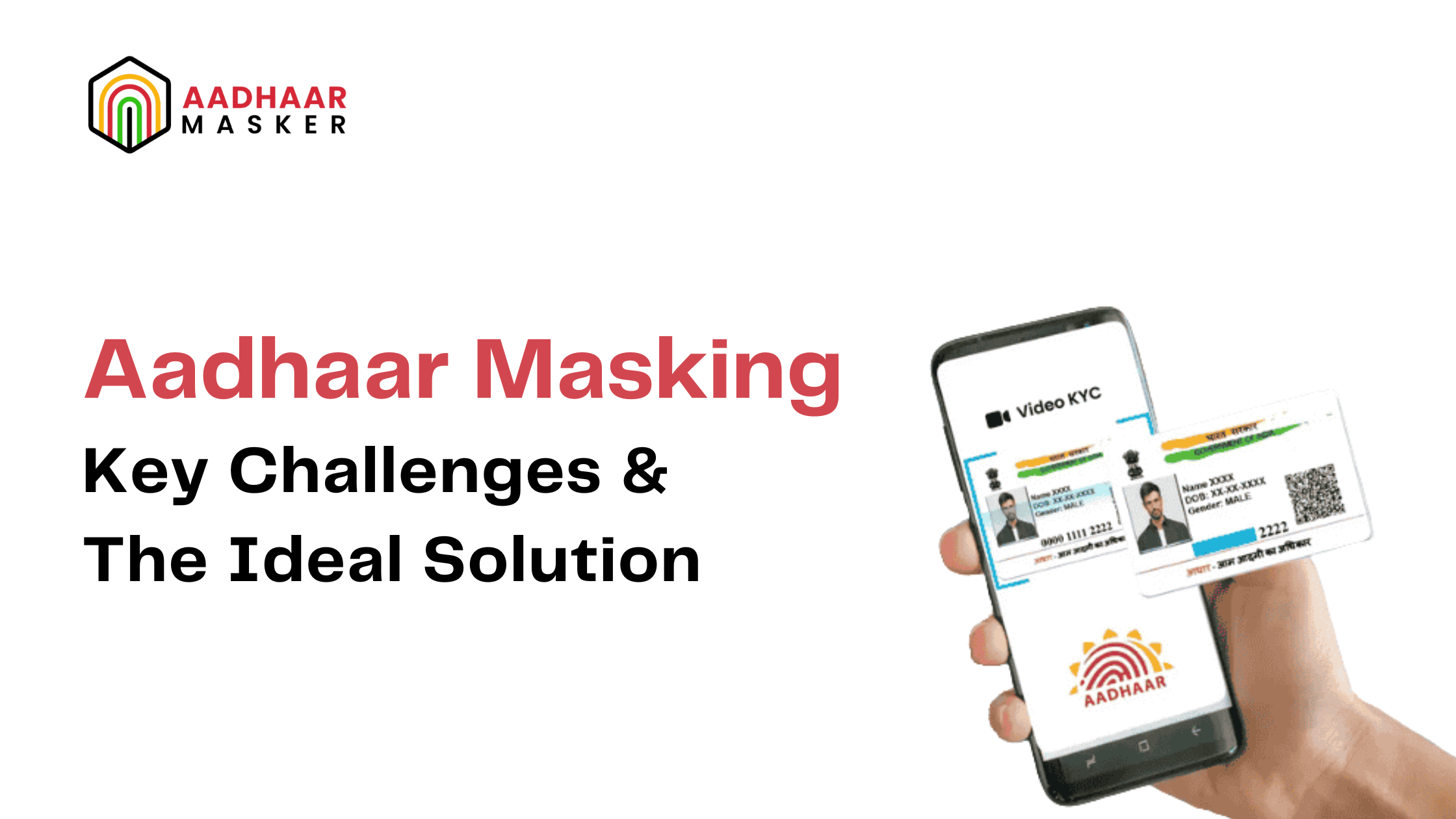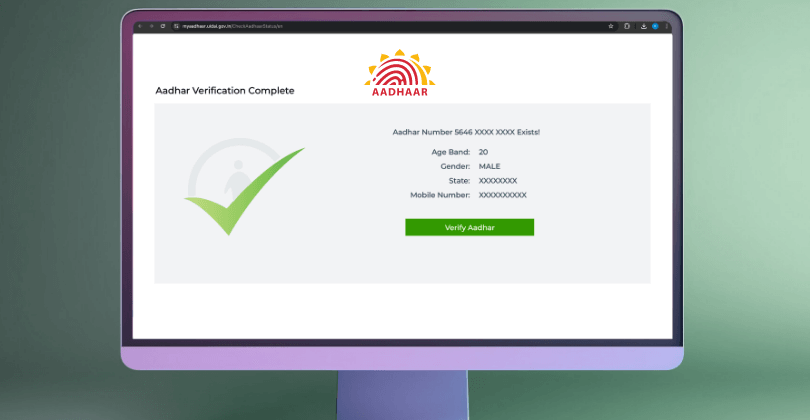Challenges to Face in Aadhaar Masking and How a Perfect Aadhaar Masking Solution Can Overcome Them ?

Aadhaar masking isn’t just another box to tick for regulators it’s a frontline defense against identity theft and financial fraud. Yet, many organizations discover its challenges only when it’s too late
In India’s digital-first governance and financial ecosystem, Aadhaar plays a pivotal role in identity verification. While it simplifies authentication processes, it also carries significant privacy risks if not handled securely. Unauthorized access to Aadhaar numbers can lead to data misuse, fraud, and legal repercussions. This is where Aadhaar masking becomes essential
In this blog, we’ll explore about
- *What is Aadhaar masking
- *How does it works?
- *Why is Aadhaar Masking Necessary?
- *Challenges to Face in Aadhaar Masking
What is Aadhaar Masking ?
Aadhaar masking is the process of redacting or hiding the first 8 digits of the 12-digit Aadhaar number on copies of Aadhaar cards.
Modern tools utilize Aadhaar masking APIs that automatically detect the Aadhaar number in an image or PDF and apply masking in real-time, ensuring privacy and compliance. These APIs use OCR (Optical Character Recognition) combined with AI to detect and redact Aadhaar numbers quickly and accurately, even in scanned documents or low-quality images
How Does It Work?
Modern Aadhaar masking APIs are built using AI-powered OCR (Optical Character Recognition). These systems automatically scan digital documentssuch as PDFs, scanned images, or mobile captures to detect Aadhaar numbers and apply masking instantly.
Key technologies involved Aadhaar masking:
- *OCR: Extracts text and numbers from various document formats
- *AI: Identifies Aadhaar number positions accurately
- *Auto-Masking Engine: Applies masking in real-time across documents
- *Secure Infrastructure: Ensures data is protected during processing
This automated process significantly reduces manual errors and supports real-time or bulk Aadhaar masking.
Why is Aadhaar Masking Necessary?
The need for Aadhaar masking arises from a combination of data protection laws, compliance mandates, and the increasing risk of identity theft.
Compliance with UIDAI Guidelines:
The Unique Identification Authority of India (UIDAI) requires organizations to mask Aadhaar numbers once KYC is complete. This is especially critical for businesses regulated by bodies such as:
- *RBI (for banks and NBFCs)
- *SEBI (for securities and brokers)
- *IRDAI (for insurance providers)
- *TRAI (for telecom operators)
Storing Aadhaar without masking can lead to serious legal repercussions, including penalties and license revocation.
Data Privacy & Risk Mitigation:
Unmasked Aadhaar data is highly sensitive. If leaked, it can be used for:
- *Financial fraud
- *Identity theft
- *Phishing or impersonation
Past incidents have shown that unmasked Aadhaar records were accessed and even sold illegally highlighting the need for robust protection mechanisms.
Challenges to Face in Aadhaar Masking and How a Perfect Aadhaar Masking Solution Can Overcome Them?
Despite its importance, Aadhaar masking comes with its own set of challenges. Understanding these helps organizations prepare and choose the right solution.
1.Low-Quality Scans of Documents:
Challenge: Most Aadhaar documents are scanned on low-resolution scanners or shot using smartphones under insufficient light. These result in a sharp degradation of the Aadhaar number clarity, which hinders OCR engines from identifying and obscuring it properly.Consequently, companies can run into compliance issues if some Aadhaar numbers remain partially exposed or go undetected entirely.
Solution: An AI-powered OCR adjusts to multiple resolutions and image states to guarantee proper detection of aadhhar card.its adaptive learning algorithms gain accuracy with time and minimize the possibility of redaction misses.
2. Aadhaar Document Variants
Challenge: Aadhaar documents are not uniform in form for all users they can be in different orientations, layouts, fonts, or languages. Aadhaar information can be embedded within other content in some documents, and this makes detection more complex.A masking solution should hence be intelligent enough to adjust dynamically to varied formats without depending on fixed templates.
Solution:Our solution accommodates multiple Aadhaar file formats and types, such as JPG, PNG, PDF, TIFF, and Base64. It automatically resize s into varied orientations, color modes, and positions of Aadhaar numbers without human intervention.
3. Manual Errors
Challenge: Masking manually is prone to inconsistencies like masking only a section of the number or not masking it at all. Human intervention, particularly in bulk processing, makes the exposure of sensitive information more likely.These mistakes can cause serious compliance violations and may even necessitate reprocessing of entire data sets.
Solution: adhaar masking is automated, removing the human factor in the process of redaction. This guarantees consistent and thorough masking each time, even with large volumes of documents.
4. Complexity of Integration
Challenge: Legacy IT systems employed by most organizations are not necessarily designed to accommodate contemporary APIs or AI-driven tools. Therefore, integrating an emerging Aadhaar masking solution may require extensive backend configurations, resource reallocation, and developer man-hours.Without a plug-and-play integration route, companies might postpone deployment and keep working under risk.
Solution: aadhaar masking provides a light-weight, plug-and-play API and an out-of-the-box dashboard requiring minimal modification to existing infrastructure. The adjustable architecture facilitates easy onboarding without interfering with current processes
5. Bulk Processing Limitations
Challenge:Challenge:In large-scale systems like banks or fintech onboarding systems, latency or inefficient Aadhaar masking solutions become a bottleneck.Delayed processing impacts turnaround time and customer satisfaction. Companies require a high-speed, scalable solution that does not skimp on accuracy during peak loads.
Solution:Aadahhar masking platform is designed to support bulk processing with high concurrency, making it possible to carry out Aadhaar masking in real-time across thousands of documents. This offers immediate turnaround and seamless customer experiences irrespective of usage spikes.
6. Non-Compliance Risks
Challenge:Persisting with storing or processing unmasked Aadhaar numbers can lead to outright flouting of UIDAI guidelines and industry-specific regulations. Non-compliance in this case can attract legal action, reputational loss, and even operational suspension.Daily audits, real-time masking, and traceable logs are a must to avoid these threats.
Solution: Aahaar masking solution platform is full UIDAI compliance by masking the first 8 digits and keeping only the last 4, with in-built audit logging. This secures your business from regulatory fines and boosts your data protection stance.
Conclusion:
At Pixl.ai, we believe Aadhaar masking is not just a compliance box to be checked—it's an imperative for privacy. Our Aadhaar masking product is built on the principles of intelligent automation, compliance certainty, and enterprise scalability.
Our Aadhaar masking API leverages advanced OCR and AI to identify Aadhaar numbers in different formats and apply precise masking—securely and in real-time. We rule out human error, cut processing time, and guarantee that each document is UIDAI-masking compliant
No matter whether you are a bank, fintech platform, government department, or telecom operator, Pixl.ai makes your Aadhaar masking efficient, precise, and future-proof.





